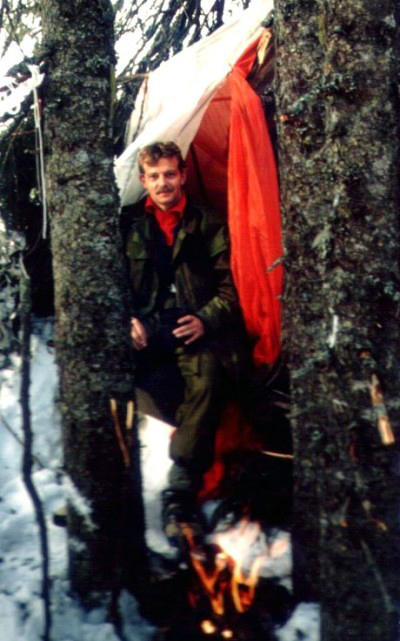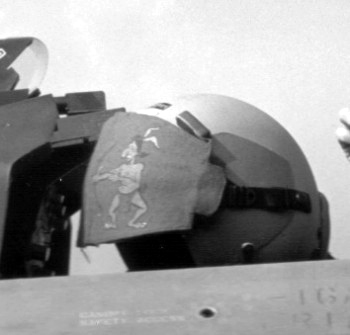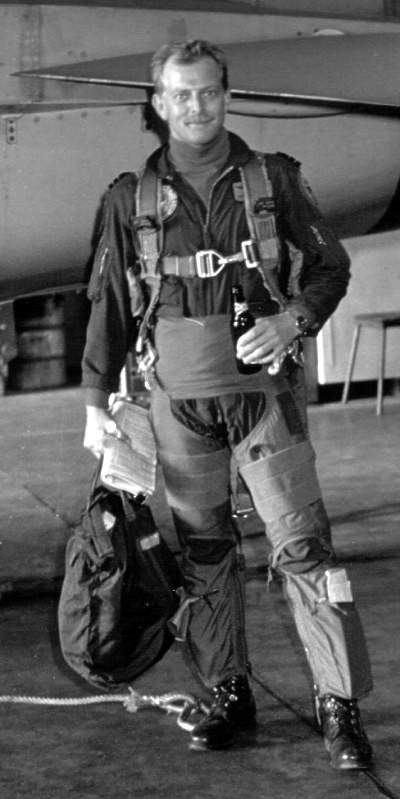After
the Going Dutch article, covering the late 60's early 70's. This article covers the last
decades of the past millennium. A different approach is used to present the facts on
flight gear in this time span. We will follow a Dutch pilot from graduation to flying the
NF-5 Freedom Fighters and later the F-16. His name is Frits "Cat"
Beenhakker.
The early days
After completing the Jet Pilot Training in the States, the fresh pilot received his wings
and returned to the Netherlands. To get used to European weather conditions, Frits, as all
new pilots, was placed at 313 Sqn that flew the NF-5A & B in 1981.
The helmet used was brought from the States, a plain white HGU-26/P dual visor helmet with
(T bayonet) MBU-5/P mask. On top of the visor housing a strip of moleskin was attached to
prevent from scratching the canopy. Some of these helmets may have been adorned with
stickers. Interesting part was the use of a foam custom fit liner (2 piece, leather
covered) in these helmets. These liners were not in use in the Netherlands at that time
and the USAF issued these with the small rubber edge beading on the helmet. The coverall
was a grey example with white zippers. Another interesting feature was the hole in the
coverall for the CSU-13B/P hose. The G-suits were worn underneath the immersion suit and
the flight coverall. Pilots already flying in the Netherlands also used the MBU-3/P mask.

The gear was completed with a grey goat
leather jacket (orange liner) and Nomex underwear. The KLu (Royal Netherlands Airforce)
used a woollen kind of undergarment at first and later turned to Nomex as well. A survival
belt was worn on the belly and contained part of the survival items. The rest is being
placed in the seat container. The EFA parachute with automatic time-release and emergency
oxygen bottle (green apple) was standard issue on the Freedom Fighter. The life preserver
used was the LPU-10/P underarm type.
The KLu life support workers modified the HGU-26/P in a later stage with the Scott Snap-On
leather edge-roll, or the thick rubber edge-roll. The latter were rejected later because
of them being combustible.
Operational flying
After finishing the European Theatre Conversion, Frits moved over to the famous 314
Squadron "Redskins" at Eindhoven Airbase in 1982. At this unit he received their
hand-painted orange visor cover depicting Humphrey the Redskin. (See also the "Visor
cover" article). Not yet assigned his nickname, the helmet was painted with his first
name only. A red shirt finished the colours of 314 Sqn.

As 314 Sqn was the airborne part of the
Netherlands part of the AMF (Allied Command Europe Mobil Force) they were on the move a
lot of times. (Hence the Redskins name) One of the frequently visited countries was
Norway. For operations in these cold weather areas, special training and equipment was
needed. Besides the normal flying gear, a special thermo style under coverall was used. An
immersion suit was worn under the outer coverall and it had a tube for the g-suit hose.
Also extra socks and a sleeping bag were part of their equipment. The sleeping back was
vacuum packed and placed between the parachute and the back padding of the EFA
set-up.
Other cold-weather survival items like a snow saw and extra flares were included in the
seat container.
Besides deploying to Norway for the AMF, several visits were made to this area (even above
the Polar Circle!) to train in arctic survival. During this training, they were taught to
make snow boots emergency signs in the snow, group shelters, tents made of parachute
clothe and tree branches. After successfully completing this course, the pilot received a
special patch that indicated his skills.

In the mid eighties, the HGU-26/P's were
modified again. This time they were sprayed grey and the painted visor cover was replaced
with a veldt covered one. Once again in orange with mascot Humphrey on it. The other
modification was made to the bayonet receptacles. Also painted grey, they were angled to
accept the Offset J bayonets on the MBU-5/P mask. During this time, the MBU-12/P was taken
in to service. A 1986 film even shows an HGU-26/P with a T bayonet fitted MBU-12/P and the
Scott snap on edge roll on the helmet. To make things more confusing an HGU-26/P with a
small rubber edge beading and an offset bayonet equipped MBU-12/P was shown. The grey
coveralls were meant to be replaced with dark grey/blue ones in 1985. But shortly after,
the first green coveralls came in fashion. At first USAF CWU-27/P's and later Seyntex
examples made in Europe. These were fitted out with two pen pockets, one on each sleeve.
1985 also saw the transition from the leather jacket to the green, also USAF, CWU-36/p and
CWU-45/P Nomex jackets. The CSU-13B/P-NL now appeared over the coverall. 314 Sqn however,
used their grey coveralls and jackets until their conversion to the F-16.
F-16 Conversion
As 314 Squadron being one of the last to convert to the F-16 in 1989, the Fighting Falcon
gear was already widely in use. But on other units, early F-16 jocks used the HGU-26/P.
Before being fitted out with the HGU-55/P; the HGU-26/P was modified to lightweight
configuration. This was done by removing the double visor and mounting lightweight oxygen
receivers. The visors were heavily modified HGU-26/P visors with snaps and straps
attached.

Frits, however, received a new HGU-55/P
with MBU-12/P. Again Humphrey showed up on the visor cover. This time veldt with Velcro
attached to mate the HGU-55/P visor. The PCU-15/P torso harness was needed to strap you in
the ACES II seat. The harness used the LPU-3/P underarm life preserver, these being
attached to it by means of zippers. The Frits "Cat" flew his last sortie in 1993
before moving to the States to become an instructor with the Euro NATO Joint Jet Pilot
Training (ENJJPT) at Sheppard flying the AT-38. Until last year Frits was a
"guest" pilot with 312 Sqn flying F-16's.

I like to thank Frits "Cat"
Beenhakker for his pictures, stories and time he made available for my questions. |